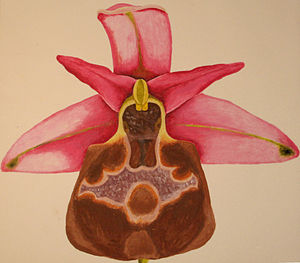Spectacle Ragwurz
| Spectacle Ragwurz | ||||||||||||
|---|---|---|---|---|---|---|---|---|---|---|---|---|

Spectacles ragwurz, illustration |
||||||||||||
| Systematics | ||||||||||||
|
||||||||||||
| Scientific name | ||||||||||||
| Ophrys biscutella | ||||||||||||
| O.Danesch & E. Danesch |
The eyewear Ragwurz ( Ophrys Biscutella ) is a kind of the genus Ragwurzen ( Ophrys ) in the family of the Orchid Family (Orchidaceae). Some authors call it the subspecies Ophrys argolica subsp. biscutella (O.Danesch & E.Danesch) Kreutz . A synonym is Ophrys crabronifera subsp. biscutella (O.Danesch & E. Danesch) Klaver & Kreutz .
This species is similar in general appearance to the hornet ragwort ( Ophrys crabronifera ).
description
This herbaceous perennial plant reaches heights of between 10 and 50 cm. The inflorescence consists of two to ten flowers . The basal field is not or barely colored lighter. Sometimes the bumps are missing. The mark usually consists of two cross-linked spots and is glasses-shaped. The red staminodal points are mostly present. The spectacle ragwurz differs from the hornet ragwurz ( Ophrys crabronifera ) by the darker trapezoidal lip with broad-lobed, projecting side lobes.
The flowering period extends from April to May.
The number of chromosomes is 2n = 36.
ecology
The bee Anthophora retusa is given as the pollinator .
Location and distribution
You can find this orchid in light forests, garrigues and on bushy grasslands with fresh mostly limestone - rarely slate- containing soils up to a height of 1300 m . You can find this plant species in the south of Italy from the province of Cosenza northwards to Salerno and Foggia .
literature
- Karl-Peter Buttler : Orchids, the wild species and subspecies of Europe, the Middle East and North Africa . Mosaik Verlag 1986, ISBN 3-5700-4403-3 .
Individual evidence
- ↑ Rafaël Govaerts (ed.): Ophrys argolica. In: World Checklist of Selected Plant Families (WCSP) - The Board of Trustees of the Royal Botanic Gardens, Kew . Retrieved May 11, 2020.
- ↑ a b Helmut Baumann , Siegfried Künkele and Richard Lorenz: Orchids of Europe with adjacent areas . Verlag Eugen Ulmer, Stuttgart, 2006, page 150.
- ^ Tropicos. [1]